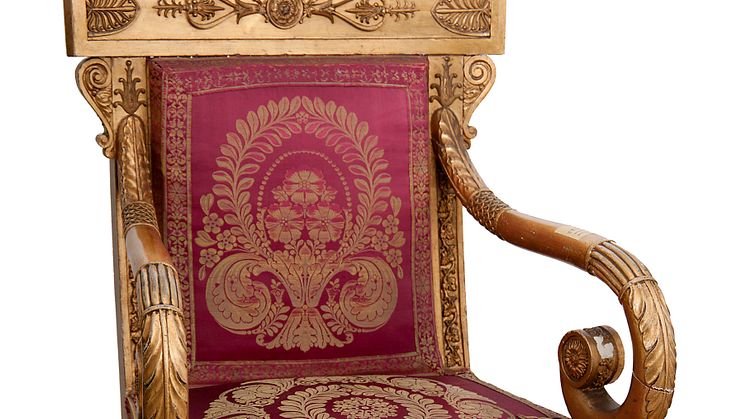
Press release -
New acquisition: Furniture suite from foreign minister’s residence
Nationalmuseum
has acquired a suite of furniture made in the 1830s and once used in the
official residence of the Swedish foreign minister. Fully gilded, and
upholstered in French silk, the suite is unusually luxurious by Swedish
standards. The closest parallel is the suite that furnishes the Lantern Room at
Rosendal Palace.
Nationalmuseum has expanded its applied art collection with the acquisition of a seven-piece suite of furniture once used in what was then the official residence of the Swedish foreign minister on Blasieholmstorg in Stockholm. Made in Stockholm, probably in the 1830s, the suite is fully gilded and is upholstered in French silk of the same vintage, decorated with a pattern scaled to the seat and back. Originally the suite comprised at least 13 pieces: two sofas, eight armchairs, two banquettes and a mirror. One sofa, four armchairs, one banquette and the mirror have now been transferred to Nationalmuseum’s ownership by the Ministry of Foreign Affairs.
The building on Blasieholmstorg served as the official residence of Sweden’s foreign minister and as a venue for official functions until the early 1960s. It is now used by the Royal Swedish Academy of Music, and the room for which the furniture was made retains its original 19th-century silk wallpaper in the same shade of red as the upholstery. When the building ceased to serve as an official residence, much of the furniture was moved to Haga Palace, which was at the government’s disposal 1966-2010. However, the suite in question was put in storage, which probably saved the original upholstery.
The design of the furniture is extremely luxurious by Swedish standards. The closest parallel is the suite that furnishes the showpiece Lantern Room at Rosendal Palace, completed around 1829. Both suites are upholstered in the same French silk, and the basic shape is identical. The difference lies mainly in the design details: The Rosendal suite has hand-carved ornamentation and is gilded with real gold leaf. The suite from the foreign minister’s residence has a simpler design, with cast lead ornamentation and a gilt effect created using metal foil and bronzing.
Nationalmuseum has acquired the pieces thanks to a transfer of ownership from the Ministry of Foreign Affairs. Nationalmuseum has no budget of its own for new acquisitions, but relies on gifting and financial support from private funds and foundations to enhance its collections of fine art and craft.
Further
information for press
Anders Bengtsson, curator applied art and modern
design
anders.bengtsson@nationalmuseum.se, + 46 8 5195 4385
Hanna Tottmar, press officer, hanna.tottmar@nationalmuseum.se, +46 767 23 46 32
Caption
Furniture suite,
1830s. Photo:
Linn Ahlgren/Nationalmuseum.
Categories
Nationalmuseum is Sweden’s premier museum of art and design. The collections comprise older paintings, sculpture, drawings and graphic art, and applied art and design up to the present day. The museum building is currently under renovation and scheduled to open again in 2017. In the meantime, the museum will continue its activities through collaborations, touring exhibitions and a temporary venue at the Royal Swedish Academy of Fine Arts, Fredsgatan 12, Stockholm. Nationalmuseum collaborates with Svenska Dagbladet, Fältman & Malmén and Grand Hôtel Stockholm. For more information visit www.nationalmuseum.se.

